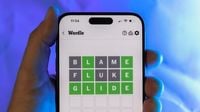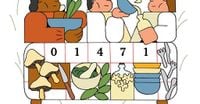Wordle continues to captivate players worldwide with its daily five-letter word challenge, and Sunday, June 29, 2025, was no exception. Puzzle number 1,471 tested enthusiasts with a clever word featuring a double letter and a somewhat tricky starting letter. The answer, "WITTY," perfectly encapsulated the spirit of the day’s challenge, referring to someone who is verbally creative, smart, and quick with humor.
Since its inception in 2021, Wordle has grown from a simple, addictive game into a global phenomenon. Created by Josh Wardle, the game’s premise is straightforward: players have six attempts to guess a secret five-letter word. Each guess reveals clues through color-coded feedback—green for correct letters in the right place, yellow for correct letters in the wrong place, and gray for letters not in the word at all. This elegant mechanic has made Wordle a daily ritual for millions.
The New York Times acquired Wordle in early 2022, recognizing its cultural significance and potential. By 2024, players had collectively attempted the game an astonishing 5.3 billion times, underscoring its enduring appeal. The game resets at midnight local time, ensuring a fresh challenge for every time zone.
For those subscribed to the New York Times Games, the experience deepens. Subscribers gain access to an archive of over 1,400 past Wordle puzzles, allowing newcomers to catch up or veterans to revisit favorite challenges. Additionally, the Wordle Bot tool offers personalized analysis, evaluating guess efficiency and suggesting strategies—an invaluable resource for players keen on improving their game.
Sunday’s puzzle, “WITTY,” was teased with several hints to guide solvers. The word begins with the letter W and contains a pair of repeated letters in the third and fourth positions. It carries the meaning of being clever or quick with words, especially in a humorous way. This clue aligned well with the word’s etymology, which traces back to Old English "wittig," meaning "wise" or "intelligent," and the root "wit," originally signifying knowledge or understanding. By the 16th century, "witty" had evolved to describe someone who is sharp and humorous with language.
Players tackling the puzzle shared their strategies and experiences. One Wordle enthusiast recounted their guessing journey: starting with “TREAD,” which narrowed the possibilities to 146 words, then “HOIST,” which reduced the options to just seven. A third guess, “MINTY,” left four potential words, before finally landing on “WITTY” as the correct answer on the fourth try. This methodical approach highlights the blend of logic and vocabulary knowledge that makes Wordle so engaging.
Competitive Wordle players often keep score based on how quickly they solve the puzzle. Guessing the word in one try earns three points, two tries earn two points, and so on, with penalties for taking too many guesses or missing the word entirely. In this friendly competition, the author and Wordle Bot both scored zero points for guessing in four attempts, keeping the monthly tally at 20 points for the author and 10 for the Bot. Such playful rivalry adds another dimension to the game, motivating players to sharpen their skills.
Not all Wordle players are familiar with the best starting words, which can significantly influence success. Experts suggest beginning with words rich in common letters like E, A, and R, while avoiding less frequent letters such as Z, J, and Q. Popular starter words include “ADIEU,” “TRAIN,” “CLOSE,” “STARE,” and “NOISE.” These choices maximize the chances of uncovering critical vowels and consonants early on.
Wordle’s difficulty varies daily, with testers reporting an average of 5.4 guesses needed to solve Sunday’s puzzle, marking it as particularly challenging. The game’s design ensures that while some days offer quick wins, others demand more thoughtful deduction. This balance keeps players coming back, eager to test their linguistic prowess.
Adding a creative touch to the daily Wordle experience, The New York Times features artwork alongside its puzzle reviews. For the June 29 edition, illustrator Alex Ram from London was spotlighted. Ram’s playful and thoughtful art often explores themes of community, mindfulness, and balanced living, resonating with the communal and reflective nature of the Wordle community.
Wordle’s simplicity belies its rich cultural impact. It has spawned countless imitators and inspired new puzzle formats, all while fostering a worldwide community of players who share their triumphs, frustrations, and strategies on social media platforms. The daily ritual of guessing a five-letter word has become a moment of connection and joy for many.
For those who missed the June 29 puzzle or wish to revisit past challenges, the New York Times subscription offers a treasure trove of Wordle games and analytical tools. Whether playing casually or competitively, Wordle remains a testament to the enduring appeal of wordplay and the joy of solving puzzles.
As the sun sets on another Wordle day, players can look forward to a fresh challenge at midnight, continuing the cycle of discovery, learning, and fun. After all, in the world of Wordle, there’s always another word to guess and another chance to be witty.


